JANICE BENNETT SUDARIUM OF OVIEDO, relationship with the SHROUD of TURIN: TEXT OF POWERPOINT PRESENTATION
A presentation made at the First International Conference on the Shroud of Turin, Panama City, Panama, June 30-July 1, 2012, which summarizes the conclusions of the research conducted by the Spanish Center for Sindonology, Valencia, Spain, since 1989.
A linen cloth popularly known as the “Holy Face” or “Holy Sudarium” has been preserved in the Cathedral of Oviedo since the ninth century. According to tradition, this linen cloth covered the head of Jesus after the Crucifixion. It was taken to Spain in a chest of relics to escape destruction during the Persian invasion of Jerusalem at the beginning of the seventh century. Until the scientific investigations conducted in the last 25 years by the Spanish Center for Sindonology, based in Valencia, Spain, little was known about this cloth and how it may have been used.
Saint John mentions the sudarium of Christ when he describes what he and Saint Peter saw in the empty sepulcher where they had buried Jesus on Friday evening: “When Simon Peter arrived after him, he went into the tomb and saw the burial cloths there, and the cloth (sudarium) that had covered his head, not with the burial cloths but rolled up in a separate place” (John 20:6-7). Since 1988 scientists have sought to answer the following questions: Is the Sudarium of Oviedo the cloth mentioned in the Gospel of St. John, and is this cloth related forensically with the Shroud of Turin?
In spite of overwhelming evidence supporting the authenticity of the Shroud of Turin, carbon dating tests in 1988 assigned a date between 1260 and 1390 for the cloth of the relic. The Shroud was immediately proclaimed fake, as if the world had thrown away the 99 pieces of supporting evidence and kept the only one that apparently denied its authenticity. It was reported that the Shroud must have been the work of a medieval forger, perhaps Leonardo da Vinci, although no one could explain how an artist might have formed an image, that, hundreds of years later, scientists are still unable to adequately explain.
That same year—1988—the Spanish Center for Sindonology, an organization based in Valencia, Spain, received official permission from the Archbishop of Oviedo to examine the relic in Oviedo known as the Sudarium of the Lord.
Their objective was to prove that both the Shroud of Turin and the Sudarium of Oviedo covered the same crucifixion victim, thus disproving the carbon dating results on the Shroud. They also wanted to determine if this crucifixion victim could have been Jesus of Nazareth.
The Spanish Center for Sindonology is a non-profit association that was founded in 1987, whose purpose is the study and dissemination of the Shroud of Turin, along with any matter directly or indirectly related to it. Its investigative team is formed by more than 30 specialists in science, language, theology, and other related disciplines. Its scientific investigations on the Sudarium of Oviedo are ongoing and have resulted in two International Congresses, held in 1994 and 2007.
The Sudarium of Oviedo is a small, rectangular linen cloth, about 34 by 21 inches (85.5 x 52.6 cm) and is therefore much smaller than the Shroud of Turin, which measures 14.3 x 3.7 ft. (4.4 x 1.1 meters). The Sudarium is dirty, stained, and wrinkled, with a large number of bloodstains, that are clear brown in color, with a “washed-out” appearance. It has absolutely no material value, other than the tradition that it covered the head of Jesus after the Crucifixion.
The Shroud of Turin is an example of a funerary linen in the time of Jesus. It was an expensive linen cloth that has an unusual herringbone weave. The Sudarium of Oviedo, on the other hand, is a small, linen cloth with a simple taffeta weave. The name sudarium is derived from the Latin word for sweat (sudor). In ancient manuscripts, the word refers to aprons, towels, napkins, handkerchiefs and turbans.
When Monsignor Giulio Ricci, a famous Italian Shroud scholar (now deceased), saw the Sudarium for the first time, he was impressed by the similarities between the bloodstains of the Sudarium and those that can be seen on the Turin Shroud. Msgr. Ricci was the first to suggest a connection between the two cloths, and his studies have contributed important information on the similarities between the two burial cloths and how the face cloth was used. Msgr. Ricci’s model of the crucified Christ shows how he believed the Sudarium would have wrapped the head of Jesus while he was still on the cross.
The obverse side of the Sudarium of Oviedo is the side that is currently exposed to the public three days each year. It is mounted in a silver frame without glass or a protective covering. The reverse side is the side that scientists believe, actually touched the face. It is dirtier, and its stains are more intense in color. It is covered with micro-scabs of blood from wounds on the head. The reverse side of the Sudarium is currently hidden because the linen has been sewn to a supporting cloth that has been tautened on a wooden stretcher. The cloth is covered with a silver frame. This photograph of the reverse side was taken after the relic was unstitched from its supporting cloth for scientific study.
The Sudarium of Oviedo has been venerated in the Cathedral of Oviedo, located in the northern region of Asturias, Spain, since the ninth century. According to many ancient manuscripts, it was brought there from Jerusalem in a chest filled with many relics. The Cathedral of Oviedo has several interior constructions that were built when the city was founded, predating the Gothic period when the main body of the Cathedral was built. The most important is the Holy Chamber that has safeguarded the Reliquary or Treasury since King Alphonsus II had it built in 812 A.D. as part of his palace. It was destroyed in an explosion in 1934, just before the Spanish Civil War, but was reconstructed several years later from the original stones. After the explosion, the Sudarium was found unharmed in the rubble, and the other relics have been restored, including the chest.
King Alphonsus II was responsible for building the Holy Chamber to safeguard the relics in 812 A.D. The room was later incorporated into the Gothic Cathedral that was begun in the 14th century. This King also built the first church at Santiago de Compostela to protect the remains of Saint James the Apostle, after they were discovered around 818 A.D. The Holy Chamber houses the silver-plated chest in its interior, surrounded by a diverse collection of relics. These relics came to Asturias shortly after the Muslim invasion of Spain in 711 A.D. and were first hidden on a mountain known as Monsacro for about fifty years. The Sudarium of Christ was among these relics, which also include two symbols of the Reconquest of Spain, the Cross of Angels and the Cross of Victory. According to tradition the Cross of Angels was made by angels to adorn the Holy Chamber. A soldier named Pelayo carried the Cross of Victory at the Battle of Covadonga in 722 A.D. This was the first decisive battle of the Spanish Reconquest after the Muslim invasion of Spain eleven years earlier.
The Arca Santa or Holy Chest, is a large chest made of oak, craved with an adz, a primitive tool, similar to a chisel. According to the LIBRO GOTICO, an ancient document found in the Cathedral’s archives, the chest was constructed by disciples of the Apostles and was taken from Jerusalem to Egypt in the second decade of the seventh century, when Chosroes II, king of Persia, persecuted the Christians in Jerusalem and destroyed the churches. It was silver-plated in 1113 A.D. at the order of King Alphonsus VI, the first king to open the chest and inventory its contents.
Because of its lack of material value, the only reason this linen was kept and venerated for centuries in a cathedral is because, according to tradition, it wrapped the head of Jesus after his crucifixion. The belief that this relic was used during Christ’s passion and death led to a liturgical rite specific to the Cathedral of Oviedo. Benediction with the Holy Sudarium was first done from a balcony made for that purpose, and it continues to take place from the main altar on three dates every year: Good Friday, and September 14 and 21, the first and last days of the Jubilee of the Holy Cross.
During the Middle Ages, many pilgrims traveling to the Cathedral of Santiago de Compostela, where the remains of Saint James the Apostle are safeguarded, also visited Oviedo. Because of their devotion to relics, they crossed the northern mountains, called the Picos de Europa, in order to visit the Cathedral of Oviedo named San Salvador. In fact, Oviedo’s relics were the reason that the pilgrims chanted this refrain: “He who goes to Santiago and not to Salvador, visits the servant, and not the Lord”.
As mentioned, the person who discovered the Sudarium in recent years was the Italian priest Monsignor Giulio Ricci, now deceased, who was formerly Director of the Center for Sindonology in Roma. At his request. Max Frei, a Swiss botanist and criminologist, took samples of pollen from the Sudarium in 1979, in order to do a comparative analysis with the pollens found on the Shroud of Turin. At least nine of the sixteen species of pollen found on the Sudarium grow in Palestine, a point of comparison with the Shroud of Turin. In contrast, species of plants from Anatolia and Constantinople found on the Shroud do not appear on the Sudarium. The Sudarium contains pollen from the north of Africa, however, indicating that both linens originated in Palestine, but followed different historical routes.
Pier-Luigi Baima Bollone, a professor of Forensic Medicine at the University of Turin and former Director of the International Center for Sindonology, was instructed by Mgrs. Ricci to carry out the first analysis of the substances found on the Sudarium. He indicated the possible classification of the blood as belonging to the group AB. This result was repeated in 1993 by hematologist Carlo Goldini and by the Spanish Center for Sindonology.
As a result of the studies done by Mgrs. Ricci, Max Frei and Baima Bollone, in 1989 the Cathedral of Oviedo granted the Spanish Center for Sindonology official permission to carry out a complete, multi-disciplinary study of the Sudarium. Their objective has been twofold: to determine if the linen in Oviedo is the historical sudarium of Jesus Christ, as tradition affirms, and to determine if it wrapped the head of the same person as the Shroud of Turin. They have used the same techniques employed in forensic investigations, including many types of photography: infrared reflection, ultraviolet light, transparency, and lateral illumination.
Scientists have determined that the Sudarium is made of linen with a “Z” twist, the most common type of weave in the Roman Empire. It has a taffeta texture, the simplest type of weave, and it does not have selvages on any of its edges, or any dye. The linen has a large number of defects, such as loops, loose basting stitches, and the crossing of parallel threads of the woof, indicating that the cloth was made on a vertical loom with weights, and that it is very old, likely from the first century.
Substances found on the cloth include post-mortem and vital blood, inorganic particles such as sand and silica and a large number of organic particles such as fungi, plant spores, remains of insects and grains of pollen. The alarming presence of fungi led to a study that concluded that the colonies are not currently active.
Remains of dust from the explosion of the Holy Chamber are present, drippings of wax, possibly from the liturgical use of the relic, and a few red stains of lipstick that possibly originate from a kiss given during an exposition to the faithful. One possibility is that it took place during the rededication ceremony after the Holy Chamber was reconstructed, which was presided over by General Franco and his wife. There are also two rectangular, parallel marks that penetrate the weave, left by a rectangular container saturated with silver paint, probably to repair the frame.
There are about thirty types of pollen grains, three of which indicate that the Sudarium was in Palestine, and the rest clearly indicate a flora belonging to the Mediterranean region. Those that indicate a presence in Palestine are QUERCUS (holm oak and kermes oak), PISTACIA PALESTINA (mastic tree and terebinth tree) and TAMARIX (tamarind tree and salt cedar).
The analysis of the white particles found on the linen was especially difficult, and they were finally identified as particles of resin of aloe and myrrh. The presence of aloe is important because it was used in ancient Jewish culture as a blood preservative. The Gospel of John says that Nicodemus came to the tomb bringing a mixture of aloes and myrrh weighing one hundred pounds. The aloe is attached to the red corpuscles and lies on top of them, indicating that it was applied to the cloth after it was already stained with blood.
The Sudarium has a multitude of wrinkles and scientists sought to answer when and why each wrinkle was formed. Linen is a type of cloth that, if not ironed, preserves its wrinkles forever. For that reason, scientists were able to obtain valuable information about how the Sudarium had been used and kept throughout its entire history. There are a number of perforations, related to the formation of the stains and the original use of the linen. Some of these were produced when the Sudarium was fastened to the head of the deceased, using sharp instruments that scientists believe were pinned to the beard and hair. They have a truncated conical nature, and appear in pairs, indicating the possibility that thorns were used. An oval hole is also seen on the linen, very possibly caused by a candle, because there is evidence of a singe and wax.
Dr. Villalain Blanco, a Spanish criminologist and forensic physician, directed the blood study to determine the nature of the stains and how they were formed. The techniques were carried out in the laboratories of criminology and forensic biology at the Schools of Forensic Medicine in Madrid and Valencia. Dr. Blanco found that the cloth was folded back on itself, because it could not completely wrap the head, most likely due to the raised position of the right arm that was still fastened to the cross. The stains penetrated the second layer, leaving a mirror image. The presence of micro scabs of blood on the reverse side of the cloth, especially on the left reverse, led the scientist to affirm that this surface was in direct contact with the flow of the blood, because the linen acts as a filter. The stains on the obverse side were within the fold, and the surface right reverse was farthest from the source of the blood.
Denominations were given for each bloodstain. Because the cloth was folded, there is a mirror image of the group of central stains, formed by post-mortem blood flowing from the nose and mouth after death. It is composed of blood and pulmonary serum in the proportion one to six, which is the reason for the “washed-out” appearance. Pulmonary edema is characteristic of crucifixion victims. The stain above it corresponds to the forehead, formed after the body had been taken down from the cross and placed on the ground. The butterfly wings stain is located where the hair was pulled back in a pigtail. The corner stain is from a wound on the back, composed of vital blood. The diffuse stain is found on the part of the linen that covered the hair on the left side of the head. It has been duplicated when bloodstained hair was placed on a linen cloth and a solution of diluted blood was added. Stains from puncture wounds are on the part of the cloth that covered the back of the head, composed of vital blood that flowed before death had occurred. The cloth was applied to these wounds about 60 minutes after they had bled, or one hour after the person had died. When death occurs, wounds stop bleeding, but the opposite is true for post-mortem blood produced during violent death from asphyxiation. It does not coagulate.
The bloodstains correspond to a human head. The principal stain was in contact with the face and appears inverted as in a mirror. The principal stain is composed of three groups of superimposed stains. A trapezoidal stain surrounds the nose and mouth, which scientists believe was formed by the pressure of a closed fist that was exerting pressure on the nose in order to contain the flow of blood. Stains in the shape of fingers also appear, formed in a similar way when the body was being moved. Outlines of the features have been drawn so that one can see the shape of the nose and the mouth.
The trapezoidal stain was one of the last to be formed, because it only appears on the first two surfaces of the cloth. It is believed that the finger-shaped stains were formed when the body was being moved to another location, in an effort to suppress the flow of blood from the nose and mouth.
It is important to remember that the bloodstains on the Sudarium were formed on a three-dimensional face and appear on a flattened cloth. It is therefore necessary to eliminate the extra two centimeters formed by the base of the nose to see how the stains conform to a face. With high contrast photography, the point of the nose can be seen, as well as the outside of the nasal cavities that are marked by an accumulation of blood. The nose is eight centimeters long, with an extra two centimeters from the base of the nose.
The lower part of the principal stains was formed with the body in a vertical position. The body had to have been in a vertical position for one hour in order to form the quantity of liquid found on the cloth (20 cc), with the right arm raised, and the head inclined 70 degrees forward and 20 degrees to the right. This position requires that both arms were suspended in the form of a cross, because otherwise the head could not have been inclined to the right. The feet had to have been fastened, because otherwise death would have occurred in 15 or 20 minutes, not enough time to produce the amount of liquid on the linen. This is the posture of crucifixion and the way Jesus is normally portrayed on the cross. From the areas of vital blood present on the linen, on the head, shoulders and back, it can be said that the Man of the Sudarium was first scourged and then crucified.
According to scientific conclusions, the upper part of the principal stain was formed by the force of gravity. Without changing the position of the arms, the body was placed in a lateral right prone position, with the head still bent 20 degrees to the right and the forehead resting on a hard surface. This position was maintained for one more hour. This means that the body was taken down and laid in a horizontal position, almost face down. After one hour, the body was moved, while someone’s left hand tried to contain the flow of bloody serum from the nose and mouth with pressure. The move was completed in about five minutes. A model demonstrates how scientists believe the linen wrapped the head while the body was still on the cross.
Once the obstacle that prevented wrapping the head completely was gone, the linen was unfolded and wrapped around the entire head as a type of hood that was still fastened to the hair with sharp objects. It was knotted toward the upper back of the head. Jorge-Manuel Rodriguez, President of the Spanish Center for Sindonology, demonstrated the second position of the cloth at the Second International Congress on the Sudarium, held in Oviedo in April 2007.
This knot was the source of the wrinkles in the corner of the cloth. It is interesting that a recently discovered fifth-century manuscript mentions that the Sudarium was knotted at the top of the head. The author, Nonnos of Panopolis, was paraphrasing the Gospel of John, Chapter 20, and added this detail. After the body was moved, it was positioned face up, and the cloth was removed from the head, still knotted. It was covered with aloe and myrrh to preserve the blood, according to Jewish custom, and the set apart in the tomb.
A comparison of the Man of the Sudarium and Jesus shows that the Sudarium of Oviedo covered a man with a moustache, beard and long hair, as Jesus is always portrayed. He was tortured, likely crowned with thorns, and then crucified. Like Jesus, he died with acute pulmonary edema and was buried in a nearby tomb. There is absolutely no possibility that he could have survived the crucifixion because the blood that flowed from the nose and the mouth made breathing impossible. After dying in a vertical position, the Man of the Sudarium was placed in a right lateral prone position. Likewise, Jesus was transferred to the tomb after first being brought down from the cross, with preliminary burial preparations.
A timetable for the crucifixion, based on Scripture and the scientific studies, shows that burial was complete according to Jewish law. Jesus died at 3:00 P.M., the Sudarium was placed on his head one hour later where it remained for one more hour until the body was taken down from the cross. A sudarium was required because blood was believed to contain the person’s soul and, according to Jewish law, it was necessary to bury it along with the body. It was also forbidden to move a mutilated body without covering it first. Preliminary anointing of the body was carried out for approximately one hour as the body was prepared for transfer to the tomb. This included rewrapping the sudarium over the head, forcing the arms from the position of crucifixion due to the rigor mortis, anointing the body with aloes and myrrh, and covering the body with a cloth. According to Jewish law, washing the body was prohibited when blood flowed at death.
John is the only Evangelist who mentions two types of linens, distinguishing between the burial linens (ta othonia) and the sudarium that had been on Jesus’ head. In the case of Lazarus, John states that he came out of the tomb with his face covered by a sudarium, indicating that this linen is small. In both cases the word sudarium has a funerary use, but this was not the only use possible. First century Latin writers use the word sudarium to refer to a large handkerchief or sweat cloth, as well as towels or aprons. A sudarium was required by Jewish law and custom to cover the face of the deceased in the case of deformity. Many ancient authors relate that it was customary to cover the faces of crucifixion victims.
One early source that mentions Christ’s sudarium is the life of Santa Nino of Georgia, who died in the year338 A.D. The writer relates that Saint Peter had hidden it, but that it was not known if its whereabouts had ever been discovered. Another writer, Isodad of Merv, also refers to Saint Peter as custodian, of the sudarium. Isodad wrote his commentaries on the Gospels in the Syriac language (a dialect of Aramaic) around 850 A.D. in what is known today as Turkmenistan (north of Iran).
He wrote that they gave the burial linens to Joseph of Arimathea, but Saint Peter took the sudarium, and it was for him a crown on his head. And every time that he laid his hands on someone, he put it on his head. He obtained frequent assistance from it, just as today the leaders and the bishops of the Church put turbans on their heads and around the neck in place of that sudarium. It is stated in Acts 19:11-12 that: “ so extraordinary were the mighty deeds God accomplished at the hands of Paul that when face cloths (sudaria) that touched his skin were applied to the sick, their diseases left them and the evil spirits came out of them “. The sudarium may have been the origin of the Bishop’s mitre and the healing cloth.
A manuscript known as San Antonino Martir, written by an anonymous pilgrim to the Holy Land in 570 A.D., mentions that there was a cave near the monastery of Saint Mark, on the other side of the river Jordan, where seven young monks lived in seven cells: they cared for the Sudarium of Christ. Many other ancient documents mention Christ’s sudarium. The LIBER TESTAMENTORUM of Bishop Pelayo is a collection of documents compiled in the seventh century. One of the documents records the transfer of the chest of relics from Jerusalem to Oviedo. It is kept in the archives of the Cathedral. The CORPUS PALAGIANUM of Bishop Pelayo is another collection that offers information on the Sudarium, along with other documents related to the first kings of Asturias. The CODEX VALENCIENNES 99, predates the LIBER TESTAMENTORUM with the history of the chest with relics, including the Sudarium, and is kept in the Library of Valenciennes, France. The GRUPO VALENCIENNES, three manuscripts found in Belgium and France, also relate the history of the transfer of the chest. The Cronica del Monje Silense was written by an anonymous monk identified with the Monastery of Silos in Spain around the year 1115 A.D. The CRONICON MUNDI was written by Bishop Lucas de Tuy before he was named bishop in 1239 A.D.
All these historical documents, from various countries and different dates, coincide in the details of the transfer of the chest of relics from Jerusalem to Spain. When the Persians conquered Jerusalem in 614 A.D., the Christians fled, carrying with them a chest filled with relics. Several documents mention that the Christians stopped briefly in Egypt, most likely Alexandria, but were forced to leave when the Persians conquered this city only two years later. By that time, the relics were already on their way to Spain, crossing the Mediterranean by boat. They entered Spain at Cartagena, stayed in Sevilla during the time of Saint Isidore, and were transferred to the capital of Toledo after Saint Isidore’s death in 636 A.D. The relics remained in Toledo for 75 years, initially in the care of Saint Ildephonsus, until the Muslims invaded Spain in the year 711 A.D.
Saint Isidore, a doctor of the Church, was an influential figure in the early Church and was responsible for caring for the Sudarium after its arrival in Spain until his death in 636 A.D. After the Muslims defeated king Rodrigo’s army in 711 A.D., they quickly conquered Toledo, so the Christians fled to the north with their relics. According to tradition, the Holy Chest of relics was hidden in a well on the top of Monsacro for fifty years. An Arabic manuscript from 977 A.D. confirms this event, saying that “many of the Christians, leaving the cities, fled to the mountains of Asturias and carrying with them all the relics they could, they hid them underground”.
In the interior of the hermitage on Monsacro, a primitive altar has been constructed over the ancient well where, according to tradition, the Sudarium was hidden. From Monsacro the caretakers of the relics could see the sea to the north and the landscape for miles around. The relics were moved to the primitive Monastery of San Vicente in 761 until King Alphonsus II built the Holy Chamber in the year 812 A.D., which was formerly part of his Royal Palace.
King Alphonsus VI authorized the first inventory of the contents of the chest in 1075 A.D. He made the difficult trip from Toledo to Oviedo in the middle of winter with his sister Dona Urraca and Rodrigo Diaz de Vivar, known as EL CID. The king was so marveled by the plethora of relics that he ordered the chest silver plated with the words, “Of the Sudarium of the Lord, and of his most precious blood”. The silver plating was carried out in 1113 A.D. and. as mentioned, was restored after it was damaged in the explosion that took place in 1934.
The chest contained many other relics, among them one of St. Peter’s sandals and a large jug from the wedding at Cana. Others were added as the chest traveled through Visigoth Spain, including the relics of Saint Ildephonsus. These relics are preserved in the Holy Chamber of the Cathedral of Oviedo. The jug from the wedding at Cana is kept in a separate place in the cathedral and is opened once a year for the veneration of the faithful.
As Monsignor Giulio Ricci first noted, the bloodstains found on the Sudarium correspond remarkably well with those on the Shroud of Turin. A simple superimposition of the photographs of the two linens, shows surprising morphological similarities.
Comparing the facial areas of both linens, the surface and shape of the nose are similar, with a length of 8 centimeters. There is swelling in the middle of the right side of the nose. The nasal cavities and wings appear as though similar pressure had been exerted on them. The right cheek shows evidence of a bruise. The position and size of the mouth coincide, with similar flows of blood along the beard from post-mortem pulmonary edema. Additionally, both linens contain the remains of aloe and myrrh, as well as pollens from plants that grow in the vicinity of Jerusalem.
The Sudarium has a number of bloodstains at the nape of the neck, which appear in the form of drops and were formed by sharp objects. Similar stains appear on the Shroud in the same position and composition. The blood type is AB
THIS ARTICLE IS THE TEXT THAT COMES WITH THE FOLLOWING POWERPOINT PRESENTATION OF JANICE BENNETT: “THE SUDARIUM OF OVIEDO” BASED ON HER BOOK: “SACRED BLOOD SACRED IMAGE, The Sudarium of Oviedo”.
POWER POINT
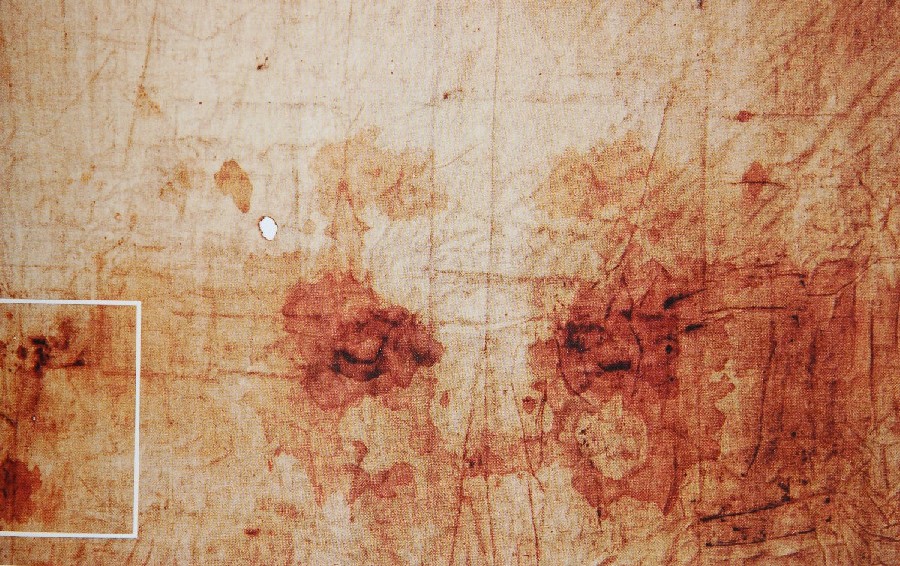
Photo 1. Sudario of Oviedo
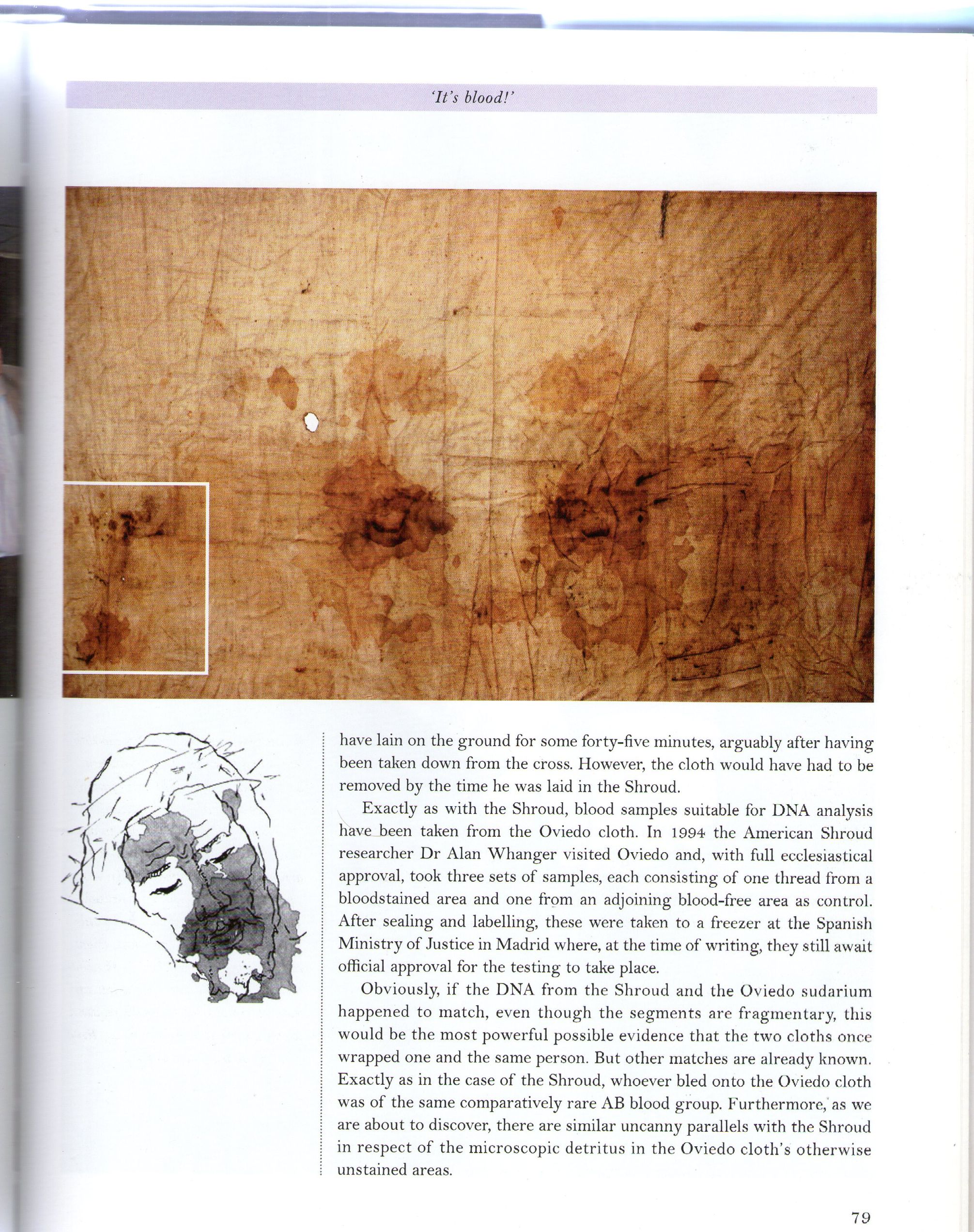
Photo 2. Sudario face image
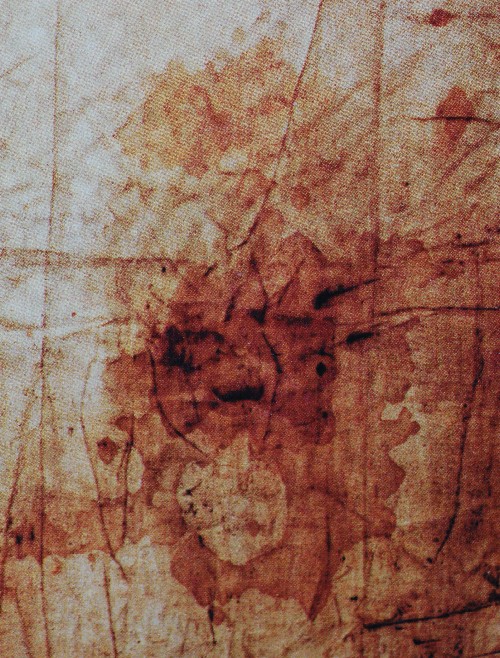
Photo 3. Drawing face image
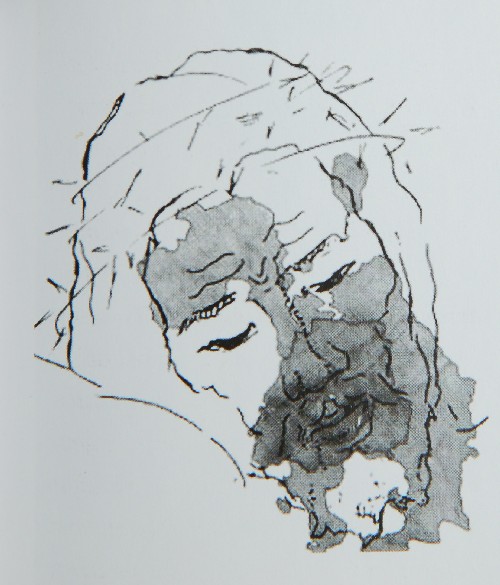
Photo 4. Face image
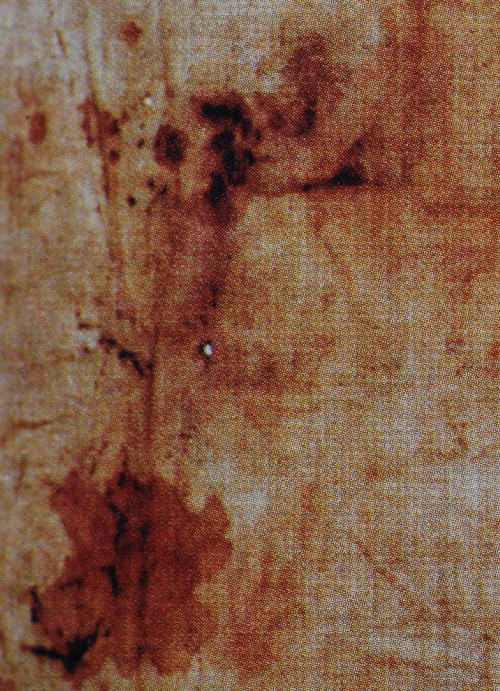
Photo 5. Back of the head
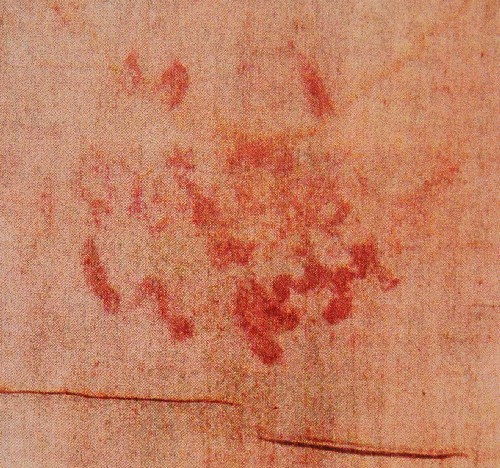
Photo 6. Back of head, blood of crown of thorns
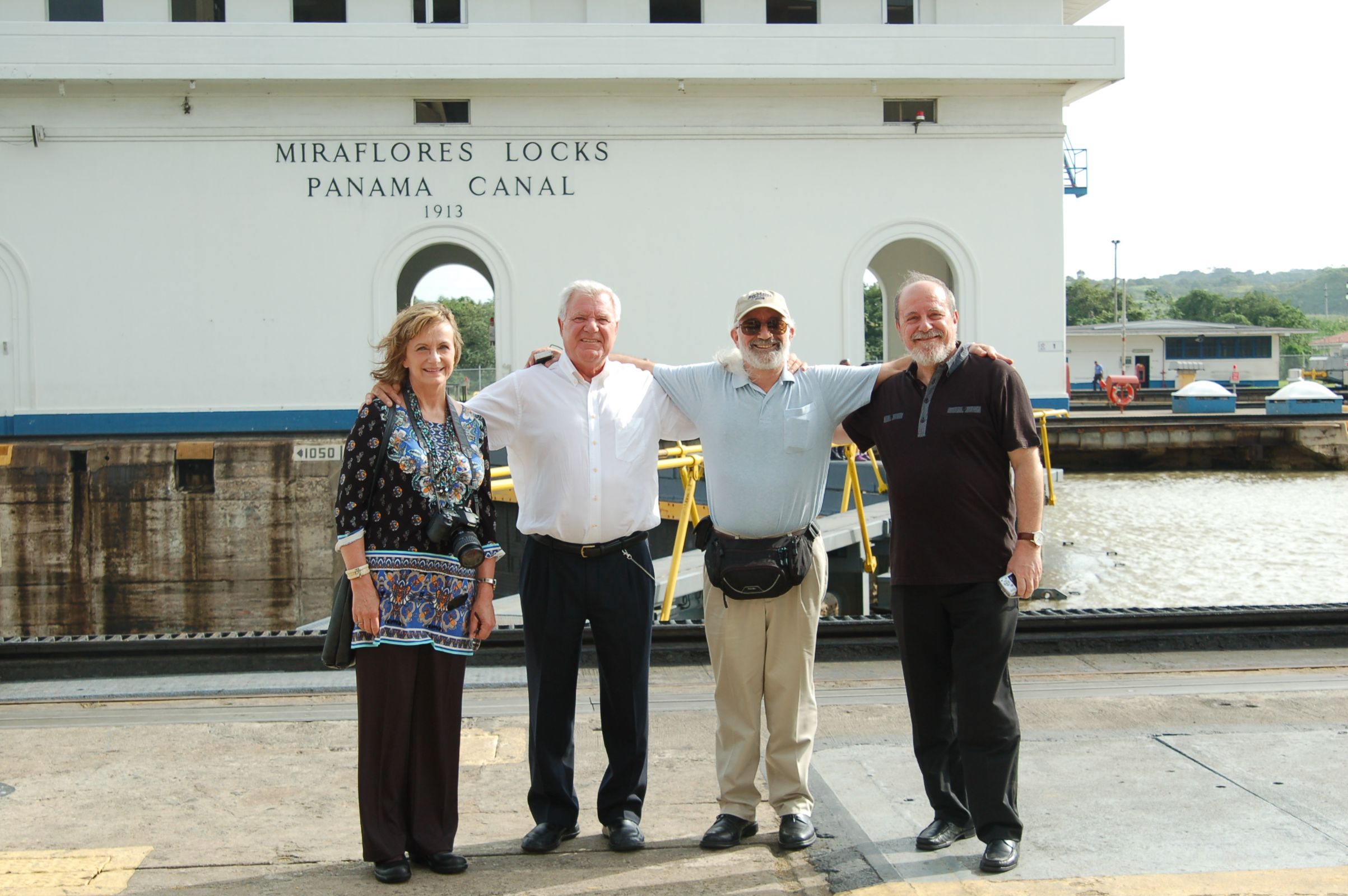
Photo 7. Conference Panama Janice Bennet, Dr. Petrus Soons, Barrie Schwartz, , Bruno Barberie
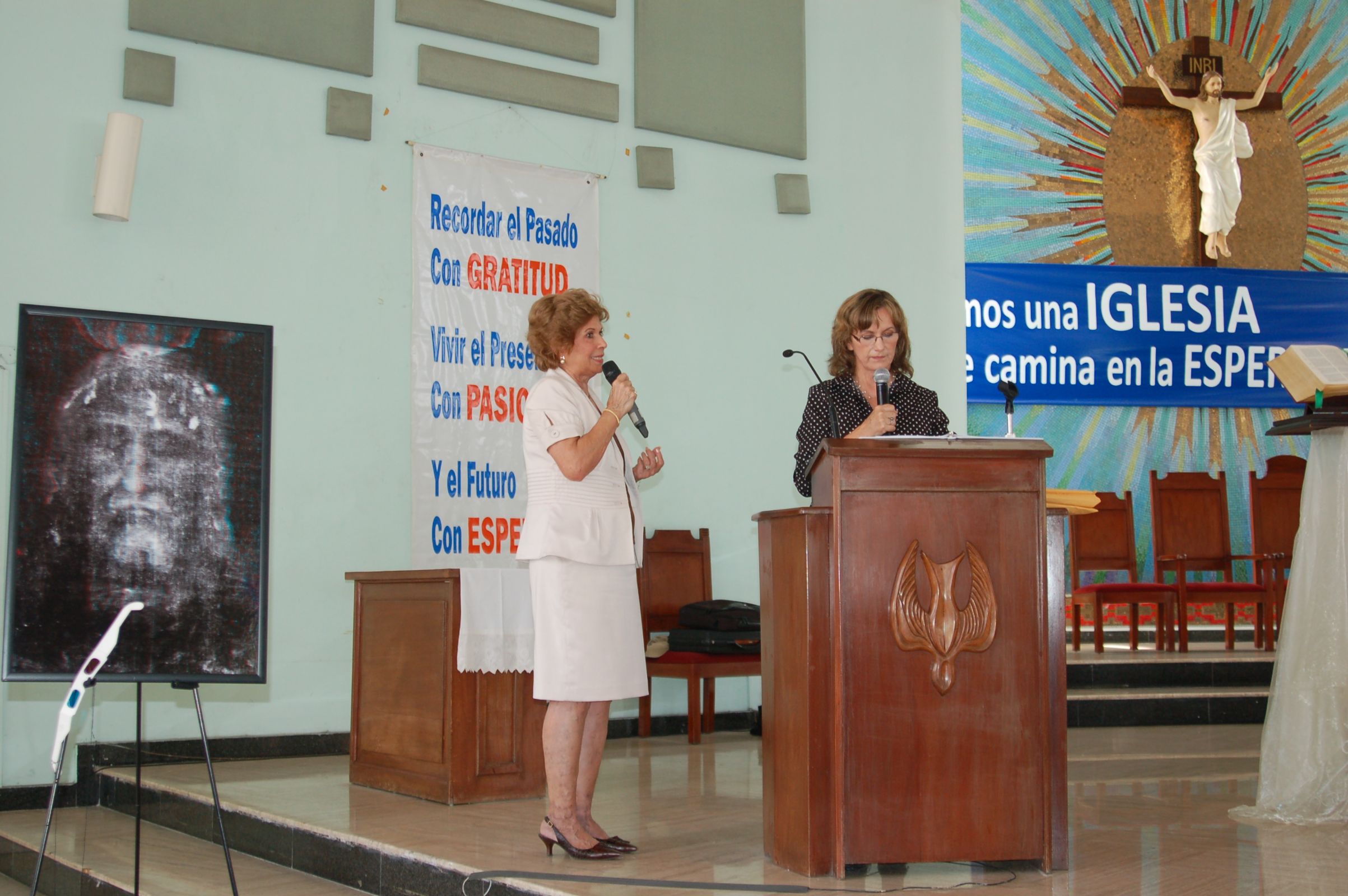
Photo 9. Conference Panama Janice Bennet and interpretor
